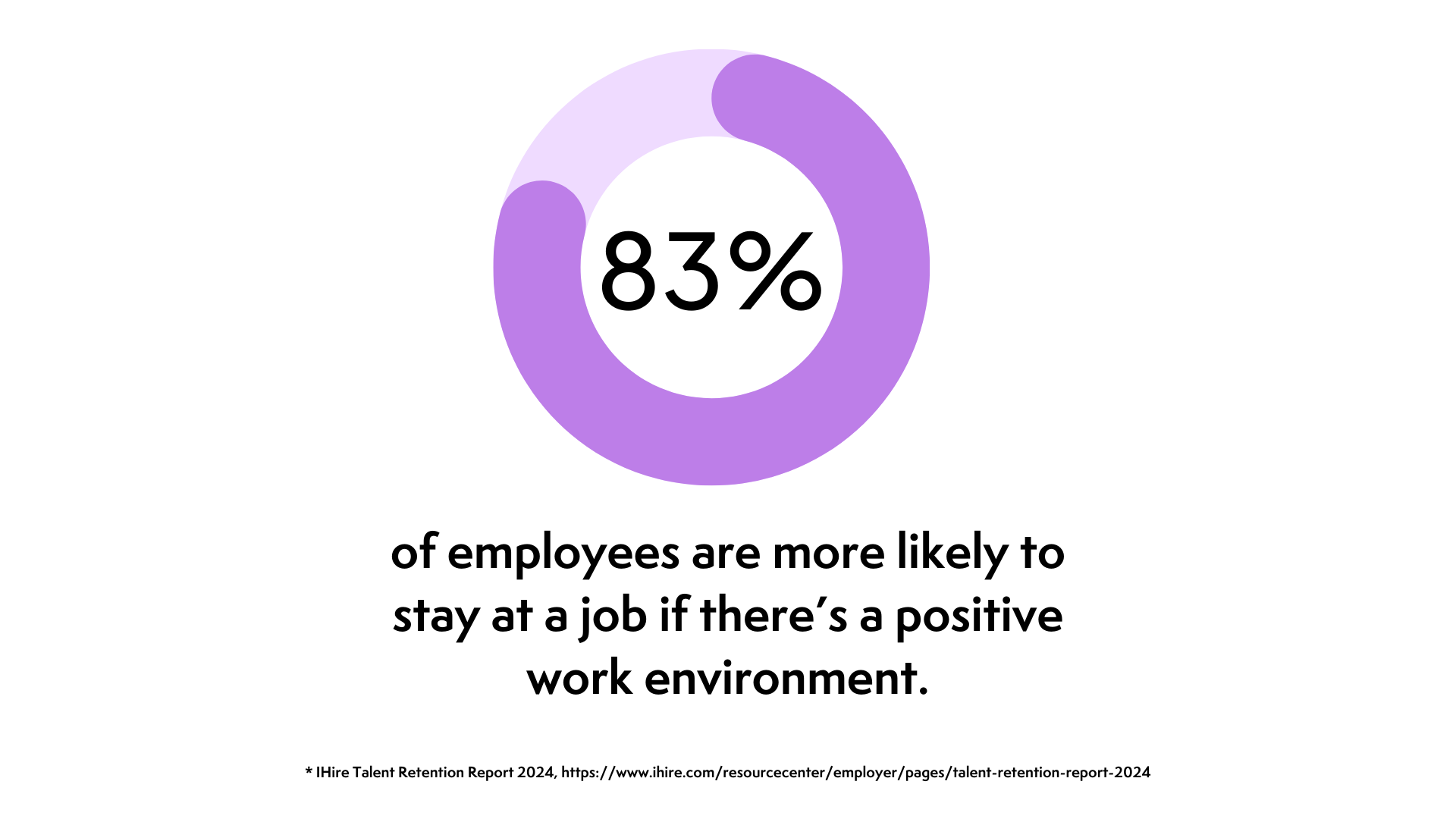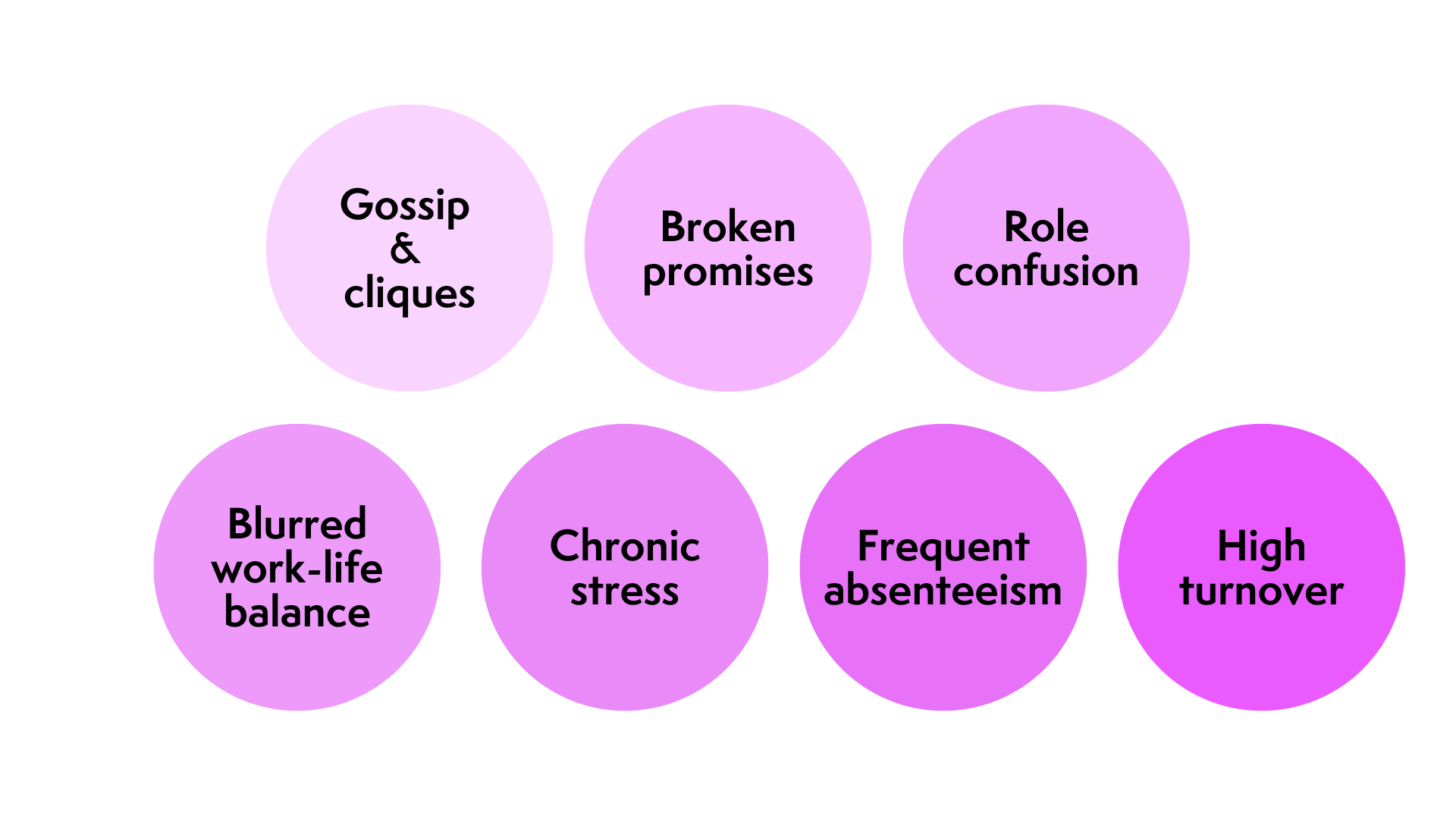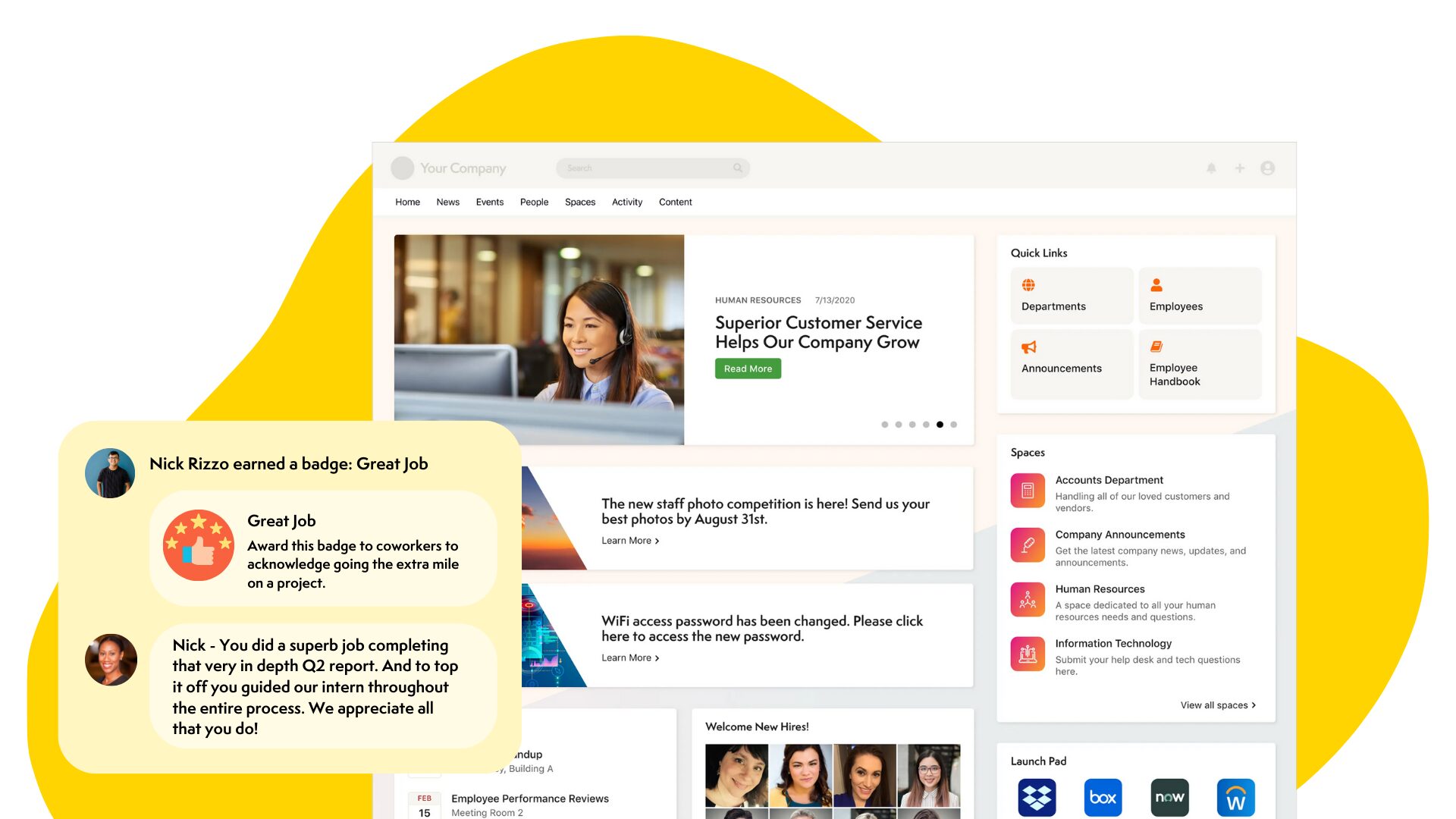Think that pay is the main reason why employees march out the door? Guess again. According to iHire’s 2024 Talent Retention survey, the main driver of voluntary resignation is a “toxic or negative work environment.”
Between wrecking employee health and bruising the bottom line, toxic work culture is like an illness to your organization; fail to address and it could be fatal.
What is a toxic work culture?
From stressed-out managers to disengaged employees, toxic work culture can take many forms. This makes it tricky to know when a workplace is truly toxic, or just unpleasant. In light of this, MIT Sloan conducted an analysis of ex-employee company reviews, out of which they were able to identify the five core toxic traits that cause people to quit their jobs.
1. Disrespect
Disrespect in the workplace is when people are treated with less dignity than they deserve. For example, a manager not listening to staff feedback, or even punishing staff for speaking out about problems. Disrespect often occurs when employers don’t trust that their employees are capable of doing their jobs properly, which may result in a culture of:
- Disregard: An employee’s voice is ignored in meetings, and their ideas are either sidelined or re-purposed by another team member—without due credit being given. Ouch.
- Micromanagement: Like the intimidating teacher who hovers over a student’s shoulder while they work, micromanagers take their supervision duties a little too seriously. They require excessive work updates, nitpick unimportant details, and squash employee growth with their controlling behaviors.
2. Lack of inclusivity
Failing to prioritize inclusive practices is a failsafe way to make employees feel alienated and “out of the loop.” This might manifest as full-blown discrimination or take the form of exclusionary cliques.
3. Unethical behavior
Ethics is the code of conduct agreed upon by a group of people, and when this is broken, there is a negative impact not only on individuals but on company culture as a whole. Maybe you hear a colleague use a racial slur, or read a report where the figures have been doctored. That horrible sinking feeling? It’s the sign of an ethical dilemma.
When workplaces let unethical behavior go with a wink and a smile, or worse, expect employees to partake in it, they erode trust, damage morale, and create a culture of optional integrity.
4. Cutthroat competition
A company full of colleagues trying to outcompete each other creates chaos. Yes, some competition can drive innovation and push employees to excel in their roles. But if the entire work culture is centered around pitting colleagues against each other? You can say goodbye to collaboration. When every person is out for themselves, knowledge sharing disappears, trust breaks down, and conflict becomes the norm.
5. Abuse
If there’s one thing that screams toxic work culture, it’s abusive behavior. Abuse can be deeply damaging to employee mental health, even resulting in Post Traumatic Stress Disorder (PTSD) in some cases. Workplace abuse includes, but is not limited to:
- Verbal attacks: Insults, belittlement, and excessive criticism.
- Physical abuse: Hitting, spitting, throwing items, and unwanted touching.
- Gaslighting: Lying with the intention of making a co-worker doubt their own sanity.
- Professional sabotage: Setting a co-worker up for failure by withholding essential information or actively sabotaging their projects in a way that will cause the blame to fall on them.
- Financial abuse: Withholding or threatening to withhold payment due to an employee.
Abuse can also take the form of enabling bullying behaviors. For instance, if an employee calls out abuse, only to be told not to make a fuss by management.
Symptoms of a toxic work culture
Now that you know what causes the toxic work culture disease, it’s time to google your symptoms. If you notice or experience multiple of the following at the office, it may be time to take action.
1. Gossip and cliques
Even if your school days were the happiest of your life, you probably don’t want your workplace to time warp back into middle school. Gossip, particularly when aimed at fellow co-workers, makes for a juvenile workplace culture that operates on the basis of “in crowds” at the expense of the “outsiders.” This is definitely not so great for the diversity, equity, and inclusion (DEI) policy.
2. Broken promises
Imagine working hard, being promised a bonus, and then it… doesn’t materialize. There are few things more demoralizing than being manipulated with a “carrot on a stick,” promises of rewards that get broken time and again. Not only does this flush motivation down the drain, but it also disintegrates any sense of loyalty.
3. Role confusion
Poor or lack of communication and unclear expectations for work roles lead to employees feeling confused about what work they should be carrying out. This tends to have one of two negative consequences:
- Incomplete work: Staff are unaware of and therefore unable to complete expected tasks.
- Redundancies: Unnecessary tasks are completed, or necessary tasks are completed twice by different colleagues.
The knock-on effect of role confusion is a team rife with misunderstandings. And the more misunderstandings mount up, the harder it is for co-workers to collaborate well together as a team.
4. Blurred work-life boundaries
If people often work past their paid hours or through their breaks, this is a symptom that they feel under an excessive amount of pressure to perform beyond what they are paid to do. Not feeling able to switch off and being expected to stay “on call” into the evenings or while on vacation leads to burnout. In fact, research by Stanford University has shown that working more than 50 hours a week does not have a positive impact on output; it actually decreases productivity.
5. Chronic stress
Chronic stress occurs when an employee experiences an overwhelming amount of pressure for an extended amount of time. It affects the mind, body, emotions, and behavior, and reveals itself in the following ways:
- Mental strain like anxiety, overthinking, and difficulty concentrating
- Physical issues such as fatigue, headaches, sleep problems, and digestive troubles
- Emotional changes like irritability, low mood, or feeling overwhelmed
- Behavioral shifts, including withdrawal, procrastination, or increased use of substances
- Workplace impacts such as reduced or even lost productivity and strained relationships
Which brings us unto…
6. Frequent absenteeism
Are the Monday blues going around at your office? Maybe they’ve even developed into Sunday scaries. If it is common for employees to call in sick, often at short notice, there’s a chance that either:
a) They feel so uncomfortable at their place of work that they make up excuses to avoid going in, or
b) They are genuinely unwell and are experiencing physical symptoms caused by the stress of a toxic work environment.
7. High employee turnover
Does your hiring process feel like a one-in-one-out revolving door? If employees aren’t sticking around, that’s a surefire way to know that something is wrong with the workplace culture. Tempting as it may be to blame it on a lack of work ethic, high employee turnover can often be traced back to hostile work environments.
The financial cost of a toxic workplace culture
A toxic work environment doesn’t only fritter away employee health; it’s also a money drain. Here’s how your bottom line will be affected, if workplace culture problems are left unaddressed.
- High employee turnover: Hogan estimates that toxic employees will cost U.S. businesses $292 billion in 2025. It’s no wonder! Recruitment and onboarding are expensive, with employee replacement costing anywhere from 50% to 200% of the ex-employee’s annual salary. Multiply that across departments, and the costs skyrocket.
- Increased absenteeism: Stress-related illness and burnout result in frequent sick days (absenteeism) or employees being physically present but mentally checked out. Both drastically reduce productivity and efficiency, leading to lost working hours and higher sick pay costs.
- Decreased productivity and engagement: Toxic environments stifle motivation, creativity, and collaboration. Employees in hostile or unhealthy work environments are far less likely to go the extra mile because the environment has made them actively disengaged. This leads to missed deadlines, poor output, and stalled innovation, all of which affect revenue.
- Higher legal and compliance costs: Toxic behaviors, such as harassment, discrimination, and bullying, can lead to costly legal battles. And even when legal action is avoided, the cost of investigating and managing these complaints is high.
- Reputational damage: When word gets out about bad company culture, there is always backlash—attracting top talent and retaining clients becomes a thing of the past. Over time, poor reputation can erode stakeholder confidence and negatively impact sales, partnerships, and long-term growth.
- Reduced customer satisfaction: Ever had your dining experience ruined by a grumpy server? It goes without saying that unhappy employees often lead to unhappy customers. Frontline staff under stress are more likely to make mistakes, deliver poor service, or disengage entirely, leading to customer churn and lost revenue.
- Wasted resources: Toxic workplaces often have significant communication gaps and duplicated work due to role confusion. That’s hours you can’t get back, and salaries paid for going in circles.
So, what’s the cure to toxic workplace culture?
Toxic workplaces are a wasteland in the business world, but that doesn’t mean they can’t be cultivated and transformed into something productive. No matter how deep-rooted toxic patterns have become in your organizational culture, there is always something you can do to turn things around. Sure, it might not be an easy process. It will probably take time. But you owe it to your staff—and even yourself—to try and fix it, especially when many of us spend a big, big majority of our time at work than anywhere else.
Encourage open communication
The beginning of every cure is a diagnosis, which means stopping to take a good look at the symptoms. One of the best ways to do this is to encourage open communication between and across all levels of the business hierarchy.
Don’t be afraid to facilitate space for open discussions about toxic patterns, or use anonymous surveys to get your finger on the pulse of how people are really feeling. Leverage your company intranet to distribute and organize comms across your company, and you’ll ensure that your people actually see and respond to them.
Create a new culture
One of the most effective ways to root out toxic workplace patterns is to focus on creating a new culture. Think of it like an organ transplant. It’s not enough to get rid of the old, damaged culture; you have to replace it with new, healthy values, and communicate these to the entire body of the organization.
Invest in leaders
Workplace culture flows down from workplace leaders, which means that leaders are your greatest asset for instilling healthy company values into the rest of the organization. Given that toxic work cultures often stem from managers feeling under-equipped for their role and mimicking toxic managerial styles that have been modeled to them, investing in leaders is central to culture transformation. By providing adequate training, you ensure that they understand core company values and have the knowledge and skills required for their role.
Clearly define expectations
It’s not just leaders that companies need to invest in! Clearly defined expectations can do wonders for employee morale as a whole. The next time you need to communicate an important update, try broadcasting it via the online work forum to ensure that everyone is on the same page. Axero intranet platform is a powerful tool you can use to streamline this process, from onboarding all the way up to leadership huddles.
Address conflict
Now for a spicy one. Perhaps it goes without saying that a negative atmosphere at work is often due to unaddressed conflict. In fact, it’s like the unseen radiation of a nuclear testing site, poisoning everything that crosses its path long after the explosion has died down. The only way to clean it up is to address it head-on by getting everyone involved to sit down and talk it through. If handled without tact, you risk kicking up the dust worse than before, but with gentle mediation, resolving conflict can actually strengthen workplace relationships.
Celebrate wins
Stopping to recognize and celebrate both individual and team accomplishments is essential for creating a positive work culture. This is because it shows employees that their work is valued and, by extension, contributes to their sense of purpose. Employers can do this by publicizing workplace wins and offering rewards for work well done.
Toxicity has no seat at the table.
If you suspect your workplace is infected with a toxic culture, finding a cure early is far better than letting it fester and decay. Enter Dr. Axero, a powerful intranet platform that packs a punch.
With the help of Axero’s suite of easy-to-use tools for communication, collaboration, knowledge sharing, and many more, you can now understand the real issues behind internal culture issues, implement the necessary changes, and enter a new era as a healthy work environment. Get a personalized demo today.

















 info@axerosolutions.com
info@axerosolutions.com 1-855-AXERO-55
1-855-AXERO-55


